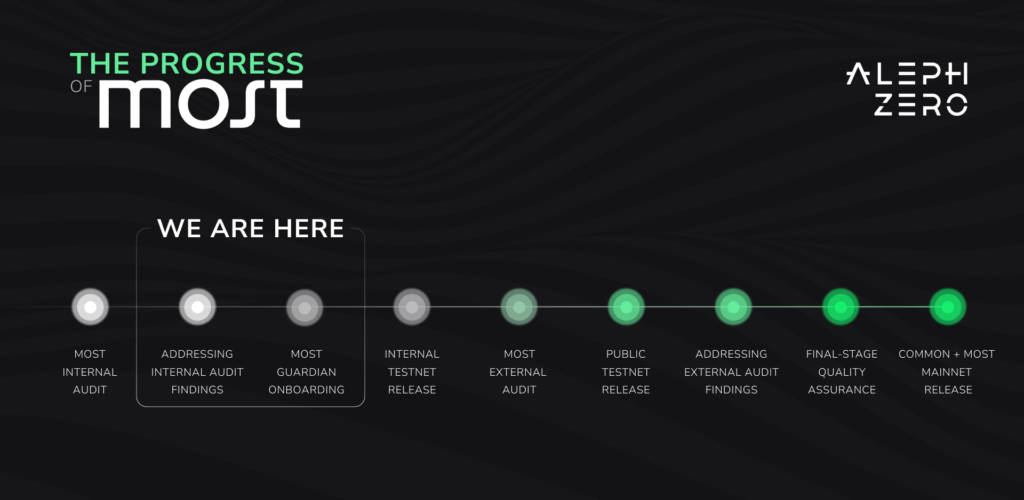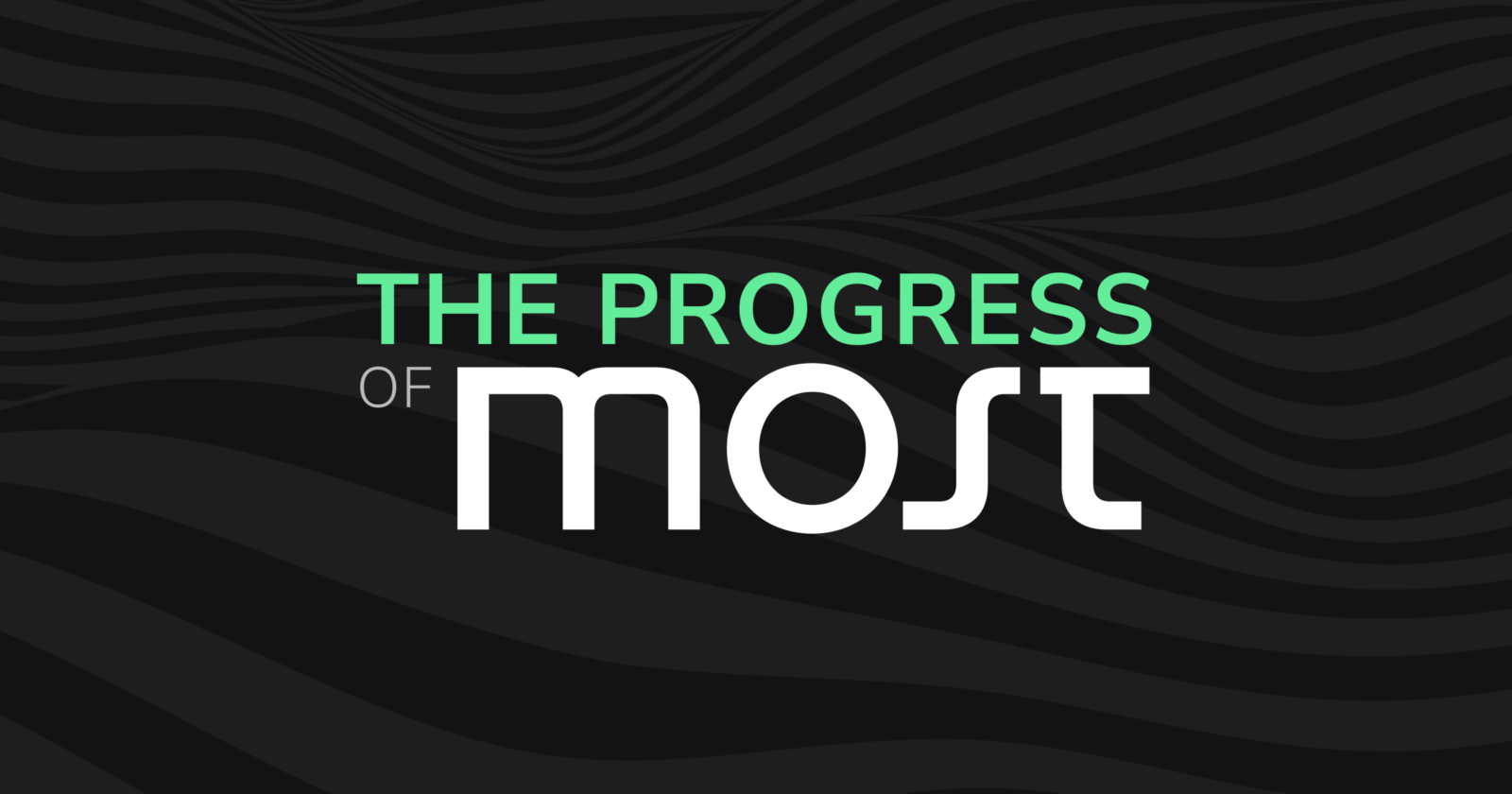MOST–the first bridge linking Aleph Zero to Ethereum–is in the final stages before it can be released on the Mainnet. Here are all the milestones that are yet to be reached before the first-ever bridge can go live for Aleph Zero.
Aleph Zero is gearing up for a significant expansion with the imminent launch of MOST, and the first-ever bridge of Aleph Zero in general. This release marks a monumental step forward in the network’s interoperability, set to enhance on-chain liquidity and user experience.
In tandem, we are preparing for the release of Common AMM, a decentralized exchange (DEX) that will operate alongside MOST, introducing a seamless on-chain trading experience.
In general, there are several major milestones that need to be reached before Aleph Zero can be connected to Ethereum, opening its first cross-chain capabilities securely. These include:
- Internal audit;
- Guardian onboarding;
- Testnet release of MOST to both Aleph Zero and Ethereum;
- External audit;
- Final-stage QA;
- Mainnet release.
Let’s dive into each of these to give you a better understanding of how close we are to deploying MOST for public use.
Internal audit – Finalizing
An internal audit represents the initial phase of security checks. It involves a comprehensive review of the bridge’s codebase by the development team and the internal security team to identify potential vulnerabilities or flaws.
Currently, the development team is rectifying issues uncovered during the internal audit. This is a crucial step as it ensures that any known vulnerabilities are fixed before external examination and wider public exposure. The development team is focused on modifying the code, enhancing security measures, and optimizing the bridge’s functionality based on the audit’s outcomes.
We expect to finalize this stage by Week 12 of 2024.
Guardian onboarding – Finalizing
Guardians play a crucial role in the security and operation of the bridge. This phase involves recruiting, vetting, and training a group of guardians responsible for overseeing and safeguarding the bridge’s operations. Their onboarding ensures that the bridge remains secure and functions correctly, adhering to the highest standards of trust and integrity.
We are currently onboarding five teams with the required technical background to operate the bridge alongside three guardians led by the core team of Aleph Zero. We have also gathered a list of guardians who have shown interest in maintaining the bridge and will work as a backup–ready to deploy their guardian nodes if there’s a need for it.

MOST Release on Testnets – Ethereum and Aleph Zero
Following the internal revisions, MOST will be deployed on the Testnets of both Ethereum and Aleph Zero. This step is vital as it allows for real-world testing in a controlled environment, enabling the identification of any unforeseen issues or bugs in a risk-free setting. It also provides an opportunity for users to interact with the bridge and provide feedback, which can be invaluable for refining the platform.
The MOST release on Aleph Zero Testnet will first happen without the public-facing interface to test for and detect the most common front-end issues before exposing the interface to the users. The public-facing Testnet release is set to come several days after that.
Both Testnet releases are set to happen in weeks 12–13 of 2024.
External audit – Planned for March 19th
Concurrently with the Testnet release, external audits will be conducted by a group of researchers. The audit competition done for Common has already proven to bring many valuable insights into the code and we plan to follow the same approach with MOST. External audits are more thorough and objective than internal reviews, providing an impartial assessment of the bridge’s security, efficiency, and compliance with industry standards. This is essential to gain the community’s trust and ensure that the platform is free from critical vulnerabilities before going live.
Before we can begin the external audit, a code freeze is required. This is a development stage that stops further updates for the time that the audit starts. However, the external audit’s findings will be addressed during the audit competition to ensure the bridge can be launched shortly after the audit concludes. It is an iterative process that may require multiple rounds of revisions and subsequent validations to ensure all concerns are adequately addressed.
The release of MOST on the Mainnet hinges significantly on the outcome of the external audit. Should any major issues be discovered, necessitating considerable development work, the launch will have to be rescheduled accordingly. If everything goes well, the external audit should be concluded within approximately two weeks.
Ensuring MOST operates well on the Testnet
Before the final launch, it is imperative that MOST demonstrates stable and secure operation on the Testnets for a sufficient period of time. We expect that it will take around two to three weeks before the Mainnet release, while this process will start just after the code freeze.
This stage allows the team to monitor the bridge under various conditions, implement any necessary final adjustments, and ensure that the system is robust and ready for Mainnet deployment.
Common AMM + MOST Mainnet release
The culmination of these meticulous preparations is the joint release of Common AMM and MOST on the Aleph Zero Mainnet. This final step signifies that both platforms have met all requisite security and performance benchmarks, marking the beginning of a new era of interoperability and innovation for the Aleph Zero ecosystem.
As you can see, the Mainnet release of Common AMM and MOST is set to happen within 4–6 weeks. The road to launching MOST on the Aleph Zero Mainnet is paved with detailed audits, rigorous testing, and continuous refinements. This thorough preparation ensures that the bridge will not only enhance the blockchain ecosystem’s connectivity and functionality but also maintain the highest standards of security and reliability for its users.

